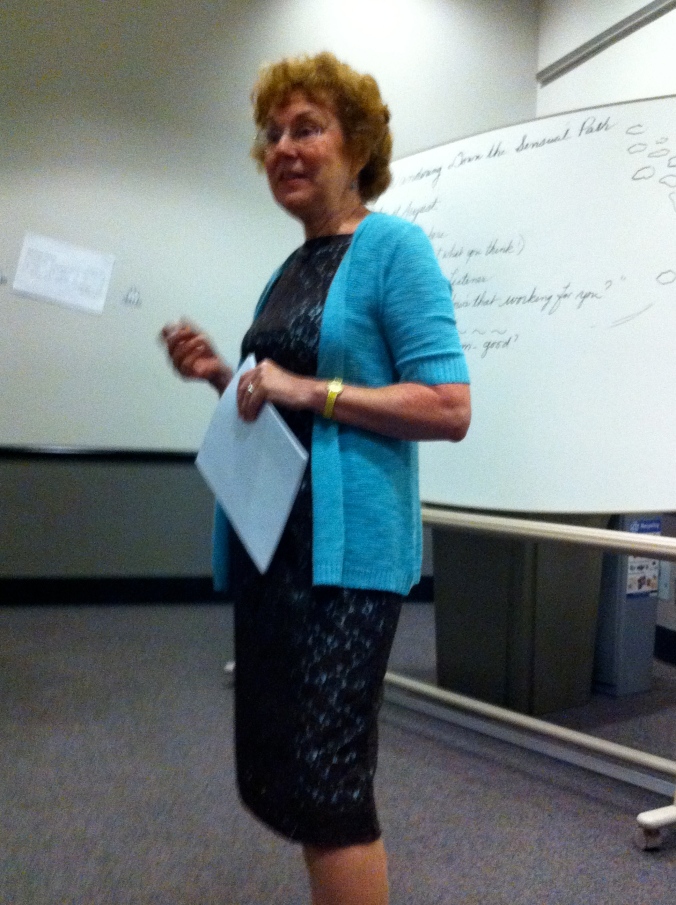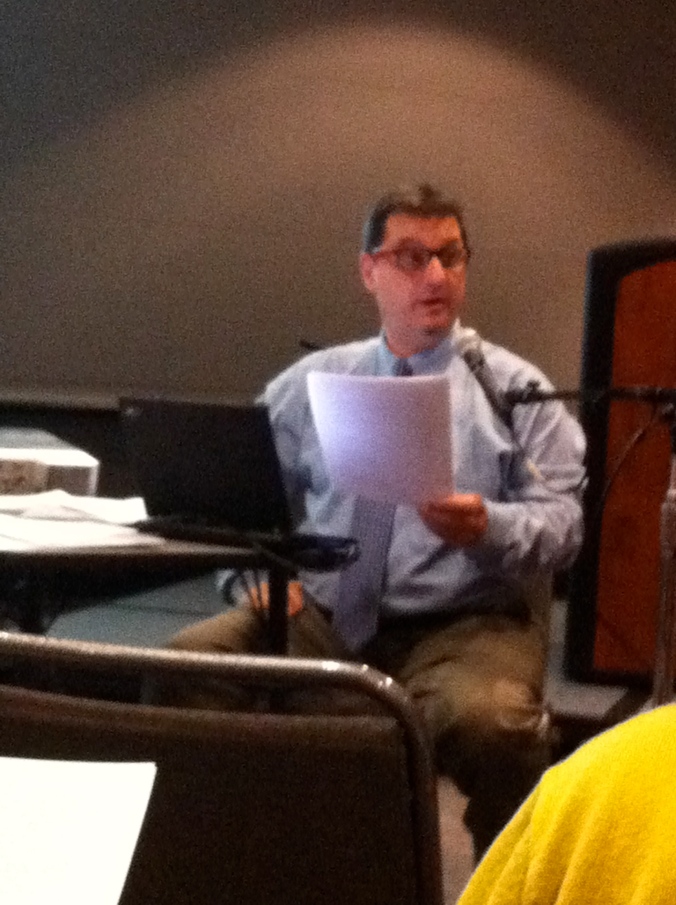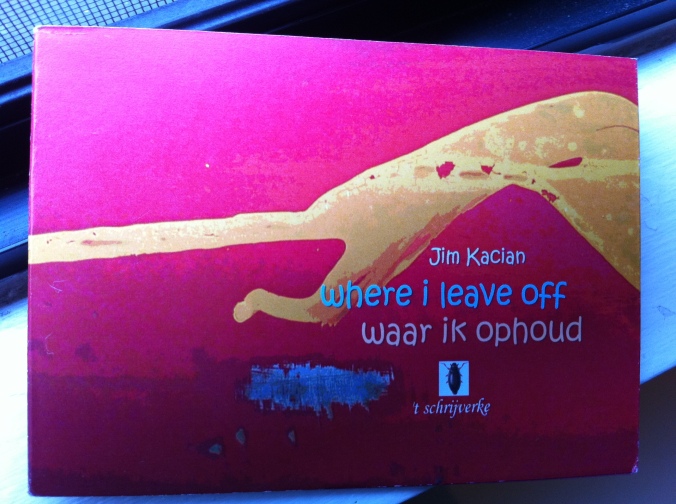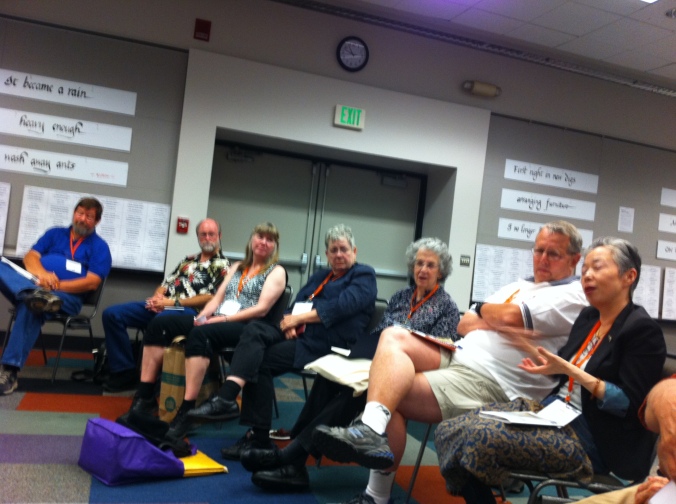Whoosh! That was the sound of my time flying by. The semester’s started up again, so no more spending Saturdays pottering around the Interwebs and lovingly polishing this column to a high sheen. Get in, get out. That’s my new motto. Excuse me, I need to go throw some laundry in the washer. You can get up and get a snack if you want. Make sure you’re back before the tour begins, though — you don’t want to miss anything.
________________
Dead Tree News
Contrary to my usual practice, I’m starting out this week with my section on print resources, in order to do justice to the great snail mail I’ve been receiving lately. You see, I finally got around to subscribing to a ton of print haiku journals, which I really should have done a long time ago. But better late than never.
You can’t find this stuff online, folks. I know it seems like everything is online these days, but this is a mirage. A whole world of otherwise invisible but glorious haiku (and other short poetry) awaits you if you will take the time to send a few hard-working editors a few bucks. In return, they will send you their lovely printed-on-actual-paper collections of lovingly selected poetry, in nice big fat envelopes that do not, praise the Lord/Allah/Buddha/Zeus, contain credit card solicitations.
So just this week I got bottle rockets No. 24 (brand-new), Lilliput Review #177 & 178 (from December), and Acorn No. 25 (from last fall, but new to me). Bottom line: They’re all worth it, get out your checkbook. More details:
- bottle rockets: a collection of short verse. Edited by Stanford Forrester, this snazzy-looking journal the size of a trade paperback contains copious amounts of haiku, tanka, and haibun. A few examples that stood out for me:
beginner’s mind …
an afternoon spent
with back issues
— Jennifer Gomoli Popolis
.
next to the temple
the industrial plant
swept spotless
— Michael Fessler
.
the kitchen clock
trying to keep
up w rain
— john martone
.
cicadas the itch under the cast
— Bob Lucky
.
first violets
it’s all about
staying small
— Peggy Willis Lyles
.
early snowfall
places the flakes miss
at first
— Jay Friedenberg
.
the most respect
we can show the dead
is not to tell them how it is:
the candle I lit
flickers
— Mike Dillon
.
still waiting
for an apology,
on my walking route
passing a garden
of forget-me-nots
— Charlotte DiGregorio
.
and I won’t quote the whole thing, but I enjoyed the haibun “To Wondering Eyes” by Liz Fenn (among others).
- Lilliput Review: In keeping with its name, this is a tiny (3.5″ x 4.25″) stapled-together zine-like publication. It’s edited by Don Wentworth (see also: Issa’s Untidy Hut), who sends two issues out into the world together to keep each other company, and contains not only haiku but short poems (up to 10 lines) of whatever form. A couple that especially struck my fancy (of the many, many I enjoyed):
.
From # 177:
snow flurries
yes and no
melt away
— Scott Watson
.
From #178:
at home
a full two hours
before I remove the hat
— paul m.
- Acorn: a journal of contemporary haiku: An attractive, minimalistic publication, about the size of a rack-sized paperback, printed on high-quality paper and laid out with care and lots of white space. Edited by Carolyn Hall, it contains only haiku, which is somewhat of a rarity for haiku publications, but makes for a nicely focused journal. Again, just a few of the poems that impressed me here:
.
rain all day
I carve the darkness
from a peach
— Marilyn Appl Walker
.
before I know it
my mind has changed …
whitebait shoal
— Lorin Ford
.
the cherry blossoms arrive without a god
— Gregory Hopkins
.
the need
to need
gull shrieks
— George Swede
.
a shadow under the pier
what it is
and isn’t
— Francine Banwarth
.
where does the time go squids of Wyoming
— Dave Russo
.
Arcturus
a pine cone glows
in the campfire
— Allan Burns
.
________________
.
Haiku in Ones and Zeroes
Back to the digital world. It all feels so ephemeral now, I must say. But no less worth reading for that. Here’s some posts from this week you might want to take a look at, starting with a couple about this week’s full moon, which haiku poets will never, ever be able to let alone:
Stop and Glow
She gets off the bus
where I’m waiting. Time to view
the moon together.
— Elissa
- And speaking of viewing the moon: Instead of trying to pick three favorites from the entries for the January Moon Viewing Party over at Haiku Bandit Society, Bandit (and his dog Dottie) threw in the towel and found a moon haiku by Issa that’s way more worth reading than any of ours. (I also HIGHLY recommend that you watch the video here of Dottie snoring.)
a toy flute trills
a cane click-clacks…
winter moon
-Issa, translated David G. Lanoue
stacking my coins
two for the ferryman
rest for the laundromat
— Johannes S.J. Bjerg
- From Andrew, Twitter name @coffeeperc, at jars of stars (originally posted on Twitter):
The swish of parting grass
as she searches
for a reason
— Andrew Rossiter/@coffeeperc
- From Tomoya Tokita via translator Fay Aoyagi at Blue Willow Haiku World, complete with fascinating translation notes:
人参を並べておけば分かるなり 鴇田智哉
ninjin o narabeteokeba wakarunari
.
if you arrange
carrots in a line
you’ll understand
— Tomoya Tokita
.
Fay’s Note: This haiku has several ‘issues’ when it is translated; 1) it sounds like ‘a sentence,’ because there is only one image; 2) because Japanese does not use ‘subject,’ this could be ‘if I arrange…’ Even in Japanese original, a reader will not know what one will understand. About a carrot? About a poet himself? Yet, I am attracted to this haiku….
— Fay Aoyagi
__________________
.
You Must Submit
This edition of the Haikuverse is going to mention Issa’s Untidy Hut a lot so you might as well get used to it. I am very excited about Don Wentworth’s upcoming new regular feature, Wednesday Haiku, for which he invites readers to send in their haiku for consideration (wednesdayhaiku AT gmail DOT com). One at a time only, folks; previously published poems okay. You’ll get a couple of copies of Lilliput Review (see above) if your poem is selected, which should be more than enough motivation for you to get something sent off to Don posthaste. As far as what qualifies as haiku, well, if you’re reading this you and Don are probably more or less on the same wavelength in that regard, but it’s still entertaining to read what he has to say on the subject:
I will not be supplying a definition of what a haiku is. You are all big girls and boys. I will simply say it is not what passes for haiku in the popular media; this site’s occasional patron and consummate poet/artist /curmudgeon, Ed Baker, likes to call them shorties, and I defer to that, since he doesn’t know so much more than I don’t know or am likely to ever not know.
— Don Wentworth
*
Another forum for publication that just sent out a call for submissions is MOONBATHING: A Journal of Women’s Tanka. This is a print journal that just published its third issue and is accepting submissions for Issue #4. Submission instructions:
Send your tanka IN THE BODY OF AN E-MAIL TO: Pamela A Babusci …
moongate44 (at) gmail (dot) com…PLEASE NO ATTACHMENTS!!! E-mail submissions only. (And oh yeah — in case this wasn’t sufficiently obvious from the journal’s title, they only accept submissions from women.)
And I know I haven’t provided much help on this blog in terms of explaining what exactly tanka are and what they do, but I’m hoping to rectify that soon because I have been writing a ton of them lately, which freaks me out a little because for a long time I had a staunch anti-tanka stance. In the meantime, a quick Google search should be able to help you out if you don’t already know what the whole tanka deal is.
__________________
A Review. Wait, Two.
1.
Ever since I first heard about Fifty-Seven Damn Good Haiku By a Bunch of Our Friends, the brilliantly-titled collection edited by Alan Summers and Michael Dylan Welch which Michael’s press, Press Here, released at the end of last year, I have been eagerly awaiting the arrival of the first reviews. Well, here (again) is Don Wentworth, giving us the lowdown. The book sounds great, I think I’ll be whipping out my checkbook again soon. Here’s a fantastic sample of one of what Don calls “the many strong voices” among the collection’s poets:
a cloud across the sun
and suddenly
I am old
— Helen Russell
2.
The other day I was hanging out in the poetry section of my local Giant Chain Bookstore Whose Poetry Collection Is Not Exactly Stellar, But It Could Be Worse, and I came across a book called Haiku Mind: 108 Poems to Cultivate Awareness & Open Your Heart, by Patricia Donegan. I looked through it and thought that the selection of haiku was wonderful, but felt kind of “eh” about the commentary appended to each one, which seemed a little too, um, enlightening for me. (I tend not to be so much about the cultivating awareness and opening your heart, more about the cultivating skepticism and keeping an open mind. I have a slight allergy to anything mystical or inspiring.) Anyway, I ended up passing on it in favor of a couple of other books (which I brought home and instructed my husband to give me for my upcoming birthday, so I’ve already officially forgotten what they are and I can’t tell you anything about them. Yet.).
But then I read, in the Autumn 2009 edition of Modern Haiku online, a review of this book by Mark Brooks (who is, besides being the editor of haijinx, a wonderful haiku poet in his own right and also not exactly a sucker for mystical treatises). First off, I knew Mark and I were on the same wavelength as soon as I read the first sentence of the review: “I own multiple copies of books I love, that way I am unencumbered enough to gift a copy whenever one matches a friend.” I do that too, you may remember. Anyway, Mark’s in-depth analysis of what exactly was contained in the commentaries for each haiku made me reconsider my quickly-drawn impression that they were all about spiritual enlightenment — apparently there is also a significant amount of scholarly information included. As Mark says,
Every haiku includes the English text, an informed discussion, and a paragraph of biographical data. Donegan even includes the headnotes for the Japanese haiku when they exist. Reliably, case by case, Donegan the teacher enriches the material for every level of reader.
Mark further suggests that this book is a good one for sharing and explaining haiku with those who are unfamiliar with it, since it does so much to clarify and expand on each haiku. So now I’m reconsidering my decision not to buy this book — I may have to head back to Giant Chain again before my birthday. Thanks, Mark.
_______________
Essays About Fun Stuff You May Never Have Thought About Before, Or Even If You Have You’ll Want to Read These Anyway
Not long ago I had a little discussion with someone about the phenomenon of the appearance of haiku that seem uncannily similar to other, previously published haiku, which if you’ve spent a fair amount of time reading haiku you know is not a rare phenomenon at all. (I have had the experience both of writing haiku that I later discovered were remarkably similar to other published haiku, which I’m pretty sure I had never read, and of reading haiku that I thought were remarkably similar to haiku I had written earlier.)
My thoughts on this subject kind of boil down to: Perhaps occasionally this is a matter of deliberate plagiarism, but far more often it probably involves either unconscious recall of the previous haiku, the fact that haiku poets are not always fantastically original in choosing subject matter (see also: full moon; falling leaves; crows; geese; butterflies; cherry blossoms; sunset; sunrise; snowfall; cicadas; and I could go on interminably but you get the idea), and also the fact that haiku are so short that if two poets happen to independently come up with more or less the same, slightly unusual image, that image will take up enough of the space of their separate poems that they will give a strong impression of being more or less the same poem.
In his very interesting essay “Some Thoughts on Deja Ku” (which is a great name for this phenomenon), Michael Dylan Welch gives many examples of uncannily similar haiku and explores what he thinks is the reason for the similarity in each instance (or asks the reader to speculate on the reason). He explores the topic in much more depth than I have here and it’s well worth a read.
*
Here’s another interesting essay from Modern Haiku, this one not a review but a scholarly examination, by Paul Miller, of the work of Japanese haiku poet Ban’ya Natsuishi, specifically his well-known series of “Flying Pope” haiku. (I originally heard about this essay while eavesdropping on a Facebook conversation about Michael Dylan Welch’s entertaining series of “Neon Buddha” haiku, which were partly inspired by the Flying Pope, and which are also briefly considered in Miller’s essay.)
This essay, too, has a great first line: “As more and more modern Japanese haiku arrive at our shore, it is worthwhile to look closer at some of them before fully stamping their passports.” This sets the tone for Miller’s essay, which is respectful of much of Ban’ya’s work while remaining skeptical that all of it is effective or even particularly comprehensible. Falling squarely in the Japanese gendai tradition, haiku such as those about the Flying Pope, which often use language in non-straightforward ways and present confusing, incongruous images, frequently bemuse and infuriate Westerners (and I’m not claiming always to be an exception to this trend). As Miller says tartly,
[I]f all the reader is looking for is clever juxtapositions or clever wordplay, then randomly picked words/images from a dictionary will suffice—and the poet is not needed. Poets are needed to convey some sense of purpose to the chosen images, and in doing so they need to be conscious of the readers. Many modern Japanese haiku do not seem to do this, and one has to wonder how Japanese editors parse such mysterious verses for publication.
Miller goes on to discuss in more detail what qualities he feels makes for effective haiku, including examples from both classical and modern Japanese haiku and modern English language haiku such as Welch’s. Most centrally, Miller feels that “a successful haiku is one that moves from the known to the unknown. The shift from realism to strangeness can be an exciting adventure, but it can also be a risk…” I find this idea fascinating, and if you agree with me, you will certainly want to read all of Miller’s excellent essay.
________________
The News in Haiku
NOTE (2/9/11): HNA 2011’s final resting place is Seattle, Washington. The conference will take place from August 3-7. Details at the above link or at the HNA website.
You may remember that a while back I featured a news story about the moving of next summer’s Haiku North America conference from Decatur, IL to Rochester, NY. Well, the latest news out from conference organizers Garry Gay, Paul Miller, and Michael Dylan Welch is this:
“Regretfully, Rochester, New York will not be able to host Haiku North America in 2011. Since the conference is such an important part of the haiku tradition in North America, and because so many poets, scholars, and editors look forward to the biennial event, work is underway to quickly find a suitable replacement location. We plan to have more news shortly.”
This is unfortunate and must be very frustrating for the conference organizers. I wish them luck in quickly finding another hosting site. (Hint: Madison, Wisconsin is lovely in July …)
________________
So wait a minute …. wasn’t this supposed to be a short one? How does this keep happening? Someday I’m going to go too far and find myself out in some part of the Haikuverse that’s previously unexplored, having forgotten my GPS, maps, and compass, and with no one around, not even a dreamy, impractical haiku poet, to ask for directions…
This must stop! Just you wait and see, next time I will be positively terse. Terse, I’m telling you! You won’t even recognize this as the same column!
(You can start the betting pool now on how likely you think this is. Don’t worry, I won’t be offended.)




























































